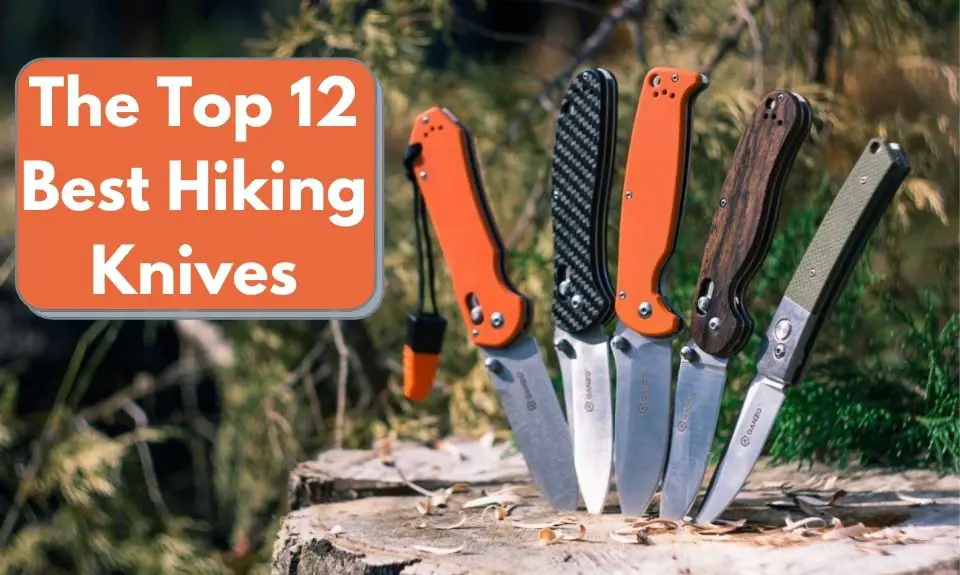Nothing’s better than getting out on the open trail for a hike and experiencing nature, but nature can be unpredictable, so it’s best that you’re prepared for anything that can come up.
One essential piece of gear is a hiking knife. Having the best hiking knife can aid you in defense, survival, and serve you well as a general utility tool.
Readers often ask us “What’s the best hiking knife?”. Well, that depends.
The best hiking knife will be easy to use, compact, durable, sturdy, and will best fit your intended uses.
Now, we realize that the intended uses may vary wildly among hikers, but there are some constants.
Read on to learn what you should keep in mind when choosing a hiking knife.
Our Top 12 Picks For The Best Hiking Knife
| Best Overall Folding Knife | Spyderco Delica 4 Lightweight Signature Folding Hiking Knife |
| Best High-End Folding Knife | Benchmade Bugout 535 Folding Hiking Knife |
| Best Affordable Folding Knife | Petzl Spatha Folding Hiking Knife |
| Best Affordable Folding Knife Runner-Up | Gerber Paraframe II Folding Hiking Knife |
| Best Heavy Duty Fixed Blade Knife | ESEE Izula II Fixed Blade Hiking Knife |
| Best Mid-Size Fixed Blade Knife | ESEE 4P Fixed Blade Hiking Knife |
| Best High-End Fixed Blade Knife | Fallkniven A1 Fine Edge Fixed Blade Hiking Knife |
| Best Full-Tang Fixed Blade Knife | Ka-Bar USMC Fighting Knife |
| Best Overall Pocket Knife Multi-Tool | Victorinox Swiss Army Huntsman Silver Tech Pocket Knife |
| Best Overall Traditional Multi-Tool | Leatherman Wave Plus 18-Function Multi-Tool |
| Best Overall Multi-Tool Runner-Up | Gerber MP600 14-Function Multi-Tool |
| Best High-End Multi-Tool | Leatherman Charge Plus TTi 19-Function Multi-Tool |
The Best Folding Hiking Knives – Our Top Picks
Spyderco Delica 4 Lightweight Signature Folding Knife

The Spyderco Delica 4 overdelivers on every promise it makes, and is an absolute powerhouse of a lightweight folding knife.
This knife combines a solid and comfortable grip with a very sharp blade right out of the packaging.
It opens and closes smoothly with one-hand and has a locking blade with a back release.
Did we mention it’s also great for using with a firestarter?
Why We Like It:
-Excellent performance
-Sharp blade that holds up to constant use
-Lightweight and one-handed open/close operation
-Compact, all-around great folding knife
Weight: 2.5 oz
Blade Length: 2.88”
Lock: Back Lock
Blade Material: VG-10
Benchmade Bugout 535 Folding Knife

The Benchmade Bugout 535 is an American-made, lightweight folding drop-point hiking knife that features high-quality CPMS30V steel.
It’s only 1.85 oz, and has a nice blade length of 3.24”. When closed, the knife only measures 4.22”, so it’s compact and easy to carry.
The axis lock mechanism is sturdy and easy to use, and the ergonomic handle makes this knife a joy to grip and use.
Benchmade has a reputation for extremely high quality and backs their products with a lifetime warranty and a LifeSharp guarantee that covers you on cleaning, oiling, adjustments, and re-sharpening for the life of your product – a huge plus in our book.
Why We Like It:
-The gold standard of what a folding hiking knife should be
-LifeSharp and lifetime warranties included
-Easy to use and handle
-Longer blade than most compact and lightweight folding knives
Weight: 1.85 oz
Blade Length: 3.24”
Lock: Axis Lock
Blade Material: CPMS30V (58-60 HRC)
Petzl Spatha Folding Knife

The Petzl Spatha is an affordable and simple hiking knife that has a good amount of functionality included.
The notch in the blade allows you to open it easily with one hand, and the textured wheel allows the user to open the knife while wearing gloves.
The locking mechanism secures the blade in the open position, making it safer to use.
The knife also has an enlarged hole making it easy to clip to a carabiner for added convenience.
Why We Like It:
-Affordable
-Compact and lightweight
-Easy to use
-Carabiner-clip compatible
Weight: 1.51 oz
Blade Length: 2.84”
Lock: Back Lock
Blade Material: 12C27
Gerber Paraframe II Folding Knife

The Gerber Paraframe II is a stylish and affordable hunting knife that provides tremendous value.
This knife features a minimal frame-lock design that offers great durability and a stable grip, and doesn’t add too much to your load at only 4.2 ounces.
The blade comes in at 3.35” inches, making it a good length for most hiking needs, and is still compact at under 5” when closed.
Why We Like It:
-Good blade length
-Lightweight and versatile hiking knife
-Affordable and compact
-High carbon steel makes this blade very durable
Weight: 4.2 oz
Blade Length: 3.35”
Lock: Frame Lock
Blade Material: High Carbon Stainless Steel
The Best Fixed Blade Hiking Knives – Our Top Picks
ESEE Izula II Fixed Blade Hiking Knife

The ESEE Izula II is the perfect example of a small knife that’s capable of doing big work.
This fixed blade drop-point knife comes with a molded sheath and clip plate and also features a carabiner hole for easy attachment.
The blade is thick and durable, and the handle is removable if you want to reduce the weight or customize it.
Ultimately, this is a good-looking, durable, and highly functional fixed blade that’s great for hiking.
Why We Like It:
-Handle features full-size handle scales
-Molded sheath & clip plate included
-Carabiner hole makes it easy to attach
-Durable and versatile
Weight: 3.2 oz
Blade Length: 2.63”
Blade Material: 1095 Carbon Steel
ESEE 4P Fixed Blade Hiking Knife

ESSE is well known in the outdoor and tactical gear space for making excellent gear, and the ESEE 4P Fixed Blade is no exception.
This knife is very well-balanced and is great for hiking and camping.
It comes with a molded polymer sheath and a textured handle for safety.
The black finish adds durability and a touch of style to this hiking knife, which is a nice add.
Why We Like It:
-Great for hiking and camping
-4.5” Blade length makes this knife very versatile
-Durable and high-quality
-Removable handle
Weight: 7.45 oz
Blade Length: 4.5”
Blade Material: 1095 Carbon Steel
Fallkniven A1 Fine Edge Fixed Blade Hiking Knife

The Fallkniven A1 is a high-end, standard-setting fixed blade knife that surpasses international standards for strength, capability, and value.
This is an all-purpose knife that’s purposely made on the larger side for heavy duty use.
The blade is made of very hard and tough laminated VG10 steel, and is a full tang knife.
An included Zytel sheath allows you to fasten the knife onto your belt and pack – even upside down.
Why We Like It:
-Long blade length
-Extremely durable and sharp blade
-Full-tang design allows for hard use and striking
-Excellent edge sharpness, edge retention, and corrosion resistance
Weight: 12 oz
Blade Length: 6.3”
Blade Material: VG10 Laminated Steel
Ka-Bar USMC Fighting Knife

The Ka-Bar USMC Fighting Knife is standard-issue for U.S. Marines, which lets you know it is extremely tough and can handle almost any situation, making it extremely suitable for the use cases you’ll encounter while hiking.
It’s USA-made, features a leather-wrapped handle, and is a full-tang heavy-duty knife.
The included leather sheath features the Marine Corps logo and the 7” blade features a serrated edge to help with cutting synthetic and looped materials, making this knife extremely versatile and very cool looking.
Why We Like It:
-7” Blade with serrated edge makes this an excellent all-situation knife
-Full-tang design and 1095 Cro-Van Steel made this knife supremely durable
-Battle tested so you know it’s up for tough jobs
-All-around great looking knife
Weight: 11.2 oz
Blade Length: 7”
Blade Material: 1095 Cro-Van Steel
The Best Multi-Tool Hiking Knives – Our Top Picks
Victorinox Swiss Army Huntsman Silver Tech Pocket Knife

No multitool list is complete without an entry from the ubiquitous Swiss Army line of multitool pocket knives, but the Swiss Army Huntsman Silver Tech is a cut above the rest.
This multitool is compact, agile and, ready to face any situation head-on.
There’s a total of 15 functions packed in a 3.6” body, and features a knife with a 2.5” blade length, giving you plenty of blade to cut with.
The additional tools like a saw blade, scissors, can opener, wire stripper, and more make sure you’re never caught without a solution to the situation you’re in while hiking or camping.
Why We Like It:
-15 tools packed in a compact design
-Great value
-Features a 2.5” drop-point blade
-Serrated saw blade ensures you can still cut plenty of material types
Leatherman Wave Plus 18-Function Multi-Tool

The Leatherman Wave Plus Multi-Tool is one of the best values we’ve seen in a multi-tool, thanks to its relatively low pricing compared to all the functions packed in.
The 2.9”, 420HC stainless-steel blade and serrated knife and saws make this tool very versatile.
All features are locking and can be operated single-handedly, making it both convenient and safe.
What’s even better is that it won’t weigh you down, coming it at only 8.5 ounces and measuring only 4” when closed.
Why We Like It:
-Lightweight and compact design
-Affordable pricing for a high-end multitool
-18 different functions, including a 2.9” blade
-High-quality and durable construction
Gerber MP600 14-Function Multi-Tool

Most people will tell you that they carry both a multitool and a dedicated knife while hiking or camping, and the Gerber MP600 is an excellent multitool for the job.
This tool can be carried many different ways, and requires very little maintenance.
The MP600 packs in 14 different functions in all, and keeps them in a sleek and slim package, making this an excellent value.
Why We Like It:
-Slim form factor and only 4.9” when closed
-14 total functions
-Includes both regular and serrated blades that lock for safety
-Rock-solid construction and dependability
Leatherman Charge Plus TTi 19-Function Multi-Tool

The Leatherman Charge Plus TTi is a higher-end multi-tool that delivers a ton of options and performance in a compact design.
The titanium handles make the tool both lightweight and strong, and the sharp S30V steel knife blades resist corrosion very well.
Additional requisite features like pliers, wire cutters, straight and serrated knife blades, and a saw are also present, making this tool extremely versatile.
Why We Like It:
-19 Tools in one
-Only 4” when closed and weighs less than 9”
-2.9” Blade length
How To Choose The Best Hiking Knife
As we discussed at the beginning of this guide, the best hiking knife for you depends a lot on what types of trails you’ll be hiking, and in what conditions.
If you’ll be hiking as part of a camping or hunting trip, this will change your needs drastically compared to simple trail hikes on established paths.
Either way, everyone needs a hiking knife for defense, safety, and survival purposes.
Let’s walk through how to choose the best knife for your situation.
Functionality
The general rule of thumb when hiking is “the less gear, the better”.
You’ll want to choose a hiking knife that is multifunctional when it makes sense.
Some knife purists are completely against multitools or swiss army knives, but the best knife you can choose is the one that will meet the most of your needs while not adding extra weight or gear to your setup.
Dependability
Think about the dependability of your hiking knife, and what you’ll be relying on it for.
Will you be clearing brush or prying things open? Best avoid a hollow-backed knife, because it won’t stand up to that rigorous use.
If you’re planning on extremely light use, a multi-tool or mid-grade metal blade will suffice.
Use Case
If you’re hiking, you’re most likely to come across the following uses for your hiking knife:
Preparing Fires
You can use your hiking knife to strike a ferro rod, shave wood, or create tinder to start a fire.
This is very useful when doing overnight hiking and camping trips, and critical if you’re camping in a damp or wet environment.
Paracord Work
If you’re using jute or paractord, you’ll need a knife for trimming and cutting.
Peeling And Chopping
If you’re doing an overnight hike or camping trip, you’ll need a sharp tool to cut and prepare, open cans or other containers, and prepare firewood.
Bushcraft
Your hiking knife will aid you in splitting wood, sharpening things, and creating other useful items in the wilderness.
If you’ll be using your hiking knife for bushcraft, it’s best to choose a fixed-blade.
Self Defense
If you come in contact with a threat on the trail, you’ll want to have a hiking knife for defense.
Small pocket knives will not do much to help you in that situation, so it’s best to look for a knife with a 4-6” blade.
Blade Size
Choosing the right hiking knife blade size is important to both your safety and comfort.
Choosing a knife that’s too large makes it hard to use properly, while choosing a knife that’s too small can result in injury.
The knife’s handle should fit perfectly in your hand to ensure you have good control over it.
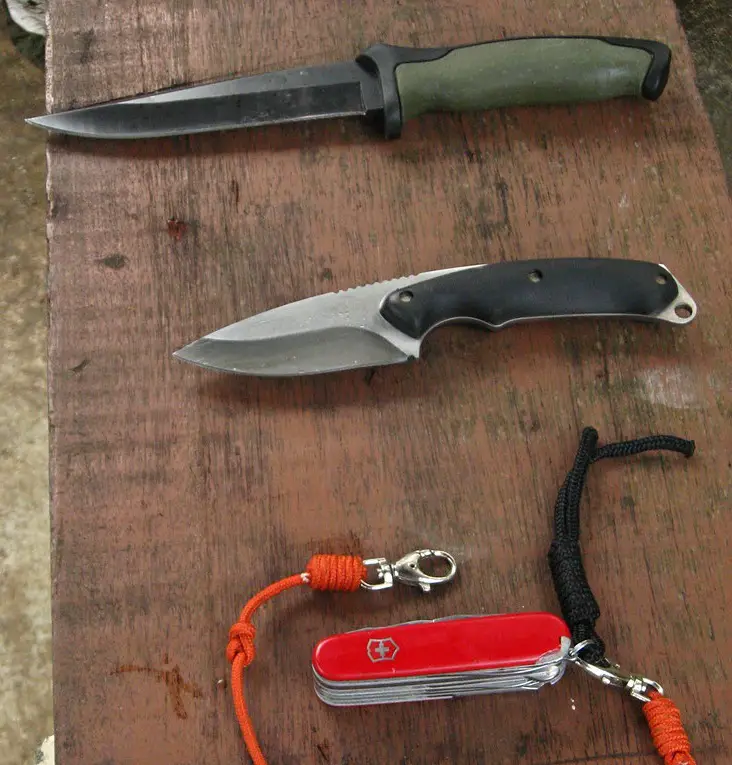
Types Of Hiking Knives
Pocket Knives For Hiking
Pocket knives – also called folding knives – feature folding blades and don’t take up much space, making them ideal for hiking, backpacking, and carrying with you every day.
The folding nature of the knife also keeps the blade protected when not in use.
The downside of folding knives is that they usually lack the stability and ergonomics of fixed-blade knives, and you run the risk of a non-locking blade folding while in use.
Fixed Blade Hiking Knives
Fixed blade knives offer better strength, ergonomics, and sturdiness compared to folding knives, and are easier to clean.
Fixed blade knives require a sheath, take up more space, and also weigh more than folding knives.
Multi-Tool Knives
Multi-tool knives are knives such as Swiss Army knives and Leatherman tools that are popular for their versatility.
The convenience they offer often comes with a sacrifice in blade quality or a reduction in performance across all of the included tools.
If you’re a casual hiker or going on established trails, a multi-tool may do just fine, but if you’ll be going into the true wilderness, you’ll want to stick with a dedicated hunting knife that offers better stability and a larger blade than a multi-tool can provide.
Hiking Knife Features
One-Handed Opening
Some folding-blade knives are designed to open using only one hand.
A stud, notch, or cutout and a smooth folding mechanism allows the knife to be opened with your thumb.
Look for a folding knife with one-handed opening if you plan on having your other hands full or if you’ll need the added convenience.
Assisted Opening
Some folding knives have assisted-opening mechanisms that engage and fully open the knife for you.
Assisted-opening knives have safety locks that stops the mechanism from working when the knife is closed so it doesn’t open in your pack or pocket.
Locking Blade
Locking blade are folding-blade knives that hold the blade in the open position after opening, and add stability to the knife.
Locking blades prevent the knife from closing on your fingers and help to avoid injury.
There are several types of locking blade styles, which we’ll cover below.
Frame Lock
A piece of the knife frame slides over behind the blade to hold it open.
The frame lock is pressed to the side by the thumb to release the blade, allowing it to be closed one-handed.
Liner Lock
This is very similar to a frame lock, with the difference of a small metal liner inside the frame holding the blade open.
Back Lock
A piece of metal along the back of the knife handle holds the blade open, and can be released by pressing on the back of the handle.
This lock type is very reliable, but requires both hands to close the knife.
Other Locking Types
Some knife brands may use a proprietary blade locking mechanism, such as rings or a tip-slider to keep the blade in place.
Fire Starting Capability
If you will be hiking overnight or camping, you’ll need to consider how to start your fire.
Some hikers and campers prefer to use a ferro rod to start their fires, and to do this you’ll need to strike the rod with your knife.
If you’ll be using your knife with a ferro rod, look for a knife that either offers a choil or that can strike a spark from the knife’s spine, providing better safety and preventing blade damage.
Choil
Some hiking knives feature a choil, which is a series of tiny cutouts or indentations on the blade near the knife’s handle.
Choils can be helpful in sharpening your blade’s edge or striking a ferro rod.
Hiking Knife Blade Shapes
There are dozens of blade shapes, but there are 5 main types you’ll find that are more common for hiking knives.
Let’s walk through the five different types of hiking knife blade shapes below.
Drop-Point Blade Knives
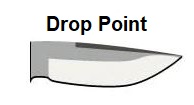
Drop-point blades feature a thick point that’s great for general knife work and a wide variety of heavy tasks.
The blade’s spine drops towards the tip, creating a shape that protects against puncturing things accidentally.
Clip-Point Blade Knives
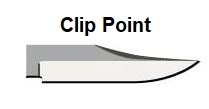
Clip-point blades feature a crescent drop on the top of the blade, creating a thin and sharp point.
Clip-point blades are excellent for puncturing and precision, but don’t offer as much strength as drop-point blades.
Tanto Blade Knives
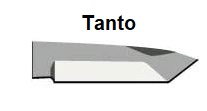
Tanto blades are heavy-duty, with a strong point and angular tip that makes them great for scraping, piercing, and prying tough materials.
Needle-Point And Spear-Point Blade Knives
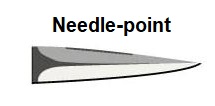
Needle-point and spear-point blades usually feature double edges and a symmetrical point.
These knives are great in survival scenarios, as they’re designed for throwing and punching.
Sheepsfoot And Santuko Blade Knives
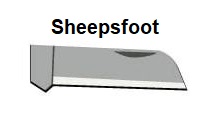
These blade styles feature a spine that rounds off steeply to the point and has a cutting edge that runs straight from the point to the handle.
This design makes it easy to chop things with, and is best suited for food preparation.
Hiking Knife Blade Materials
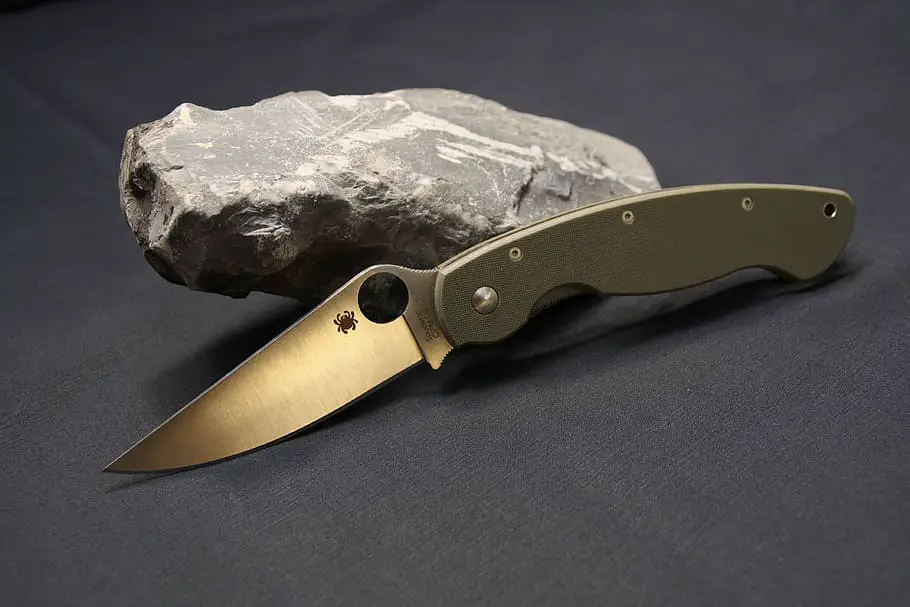
Ultimately, your knife blade should retain a sharp edge over sustained periods of use, sharpen easily, and resist corrosion or deterioration.
There is always a balance here though, as harder steel holds a better edge but is harder to sharpen and is less rust-resistant.
Conversely, softer steel is easier to sharpen, is more resistant to rust, but doesn’t hold an edge for as long as harder steel.
Stainless Steel (SS) Blade Knives
Most knife blades are made of stainless steel, which is a rust and corrosion-resistant alloy.
We’ll cover through three of the most common stainless steel types used in the best hiking knives below.
420HC Stainless Steel
420HC stainless steel offers decent edge retention, sharpens easily, resists corrosion, and is affordable.
154CM Stainless Steel
154CM is a higher-grade stainless steel that offers better hardness and longer edge retention due to a higher amount of carbon.
S30V Stainless Steel
S30V is the high-end stainless steel variant, containing vanadium and offers excellent edge retention.
High-Carbon Steel (HC) Blade Knives
Some knives feature high-carbon, non-stainless steel.
These blades are superb at hardness and keeping an edge for a long time, but are very susceptible to corrosion due to their lack of stainless steel.
Steel Additives
Although most knife blades are made from steel (a combination of iron and carbon), certain additives may be added to enhance the knife blade’s properties.
Carbon
The higher amount of carbon increases a blade’s hardness.
Nickel
Nickel aids in toughness, hardness, and corrosion resistance.
Chromium
Chromium assists in hardness, corrosion resistance, and wear resistance.
Molybdenum
Molybdenum will reduce a knife blade’s susceptibility to putting caused by environmental chemicals such as chloride, and also improves the tensile strength, hardness, and corrosion resistance of the blade.
Vanadium
Vanadium increases the strength, hardness, and wear resistance of steel.
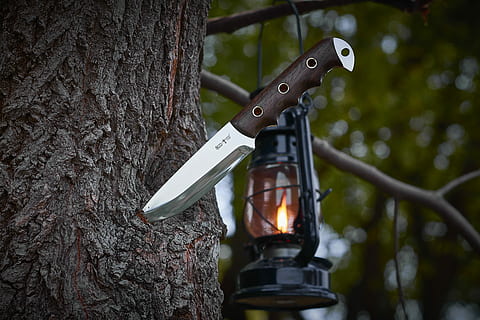
Straight Edge Vs Serrated Hiking Knives
The edge of your hiking knife blade should sustain sharpness and be easy to sharpen, and can come in a either a straight (flat), serrated, or combo edge.
Straight Edge (aka Flat-Edged) Knives
Straight edge knives feature a smooth edge, making them easy to handle, clean, and sharpen.
The continuous edge makes this knife more versatile than other edge styles, and it’s easy to use for clean push-cuts on soft materials like foods or cord.
Flat-edged knives are most popular for hiking and hunting, however it does not retain sharpness as long as a serrated-edge.
Straight edge knifes are not recommended for sawing through tough items like wood or brush.
Serrated Edge Knives
Serrated edge knives are typically combo edges, featuring a serrated blade near the handle and a flat edge towards the tip.
This gives you the advantage of having two edges to handle a situation where either push cuts or saw cuts are appropriate, and these knives have a lot of versatility.
Combo edge knives can be harder to sharpen due to the serrated edges, but are well worth it in the long run due to their ability to be used in a variety of situations.
Hiking Knife Handle Materials
The handle material of your hiking knife is extremely important, as it plays a big role in the comfort and firmness of your grip.
Choosing the wrong handle can open you up to injury or mistakes, so let’s cover the different handle material types.
Wood Handles
Wood handles look great and provide good grip, but like all wood they’re more susceptible to water damage.
Plastic Handles
Plastic handles can be slippery (especially if they don’t have a textured pattern), but are affordable and good at resisting moisture.
Rubber Handles
Rubber handles lack durability, but offer superior grip and great water resistance.
Stainless Steel and Aluminum Handles
Stainless steel and aluminum knife handles are extremely durable and relatively moisture-resistant, but can be slippery and feel cold in your hand when using them.
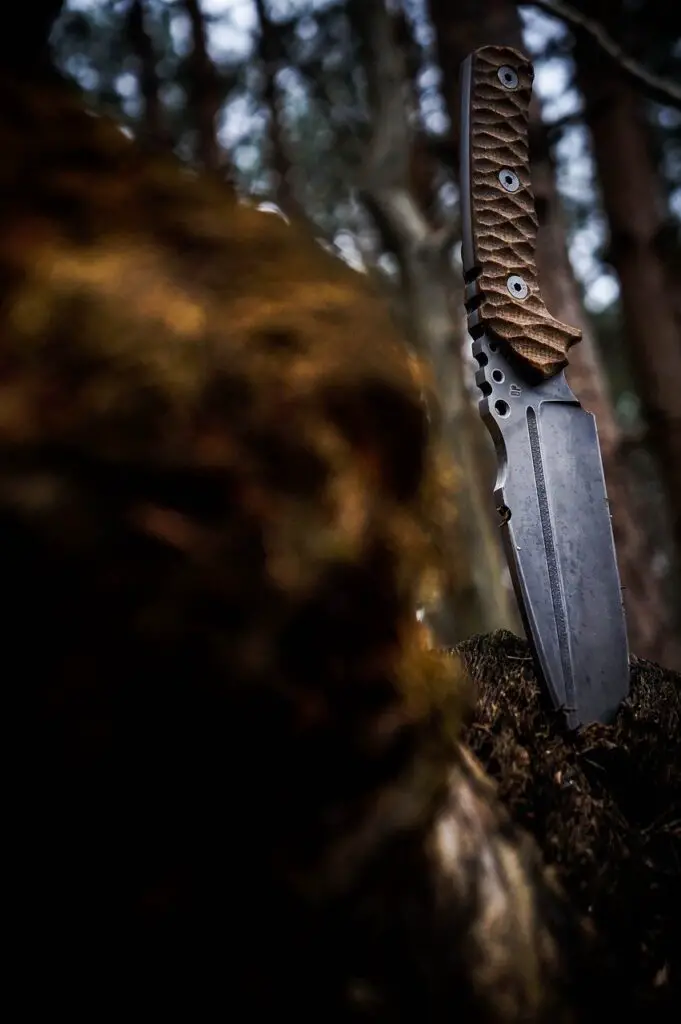
Hiking Knife Construction
It’s important to know the different components when choosing the best hiking knife.
What can really look like a simple tool really has quite a few pieces to it, and knowing the difference can help you make the right knife choice for your hiking trips.
We’ll walk you through all the different components of hiking knives below.
Spine
The spine of the knife blade is the unsharpened backside of the knife that provides flexibility and strength.
Edge
The edge is the sharp and cutting side of the knife. The edge is created by using a grinding pattern to shape the blade for different types of uses.
Cheek
The knife’s cheek is the segment between the spine and edge.
Choil
The choil is an indented portion of the edge at the beginning of the blade near the handle. The choil prevents your hand from sliding onto the blade’s edge.
Guard
Located between the handle and the ricasso, this prevents the hand from sliding onto the blade.
Ricasso
The ricasso is an unsharpened length of blade that reinforces the connection between the knife’s blade and handle portions, located just above the guard.
Bolster
The bolster is a band of steel that joins the knife’s handle to the blade, and provides protection by keeping the hand from slipping to the edge on knives that do not feature guards.
Tip
The blade’s tip is the knifepoint, used for intricate and detailed cutting.
Heel
The heel is the rear section of the knife’s edge near the handle.
Butt
The butt is the end of the knife’s handle. Some knife butts may feature a loop (or a keyring in the case of something like a Swiss Army knife).
Pommel (Butt Cap)
Pommels may be added to handles to secure the handle or guard, and also adds balance to the knife.
Rivets
Rivets are connections that secure the tang to the handle material, and are often paired with glue or epoxy.
Jimping
Jimping (not to be confused with serrations) is an area of the spine that has been ground down to create indentations that may look like teeth to someone not familiar with knives.
Jimping is not sharp, and allows the knife handler to put a thumb or finger on the jimping in order to better control the knife blade during use.
Serrations
Serrations are sharp teeth cut into the spine or blade edge (or both) to aid in saw cuts and cutting tougher material.
Saw Teeth
Some knives feature saw teeth as an added convenience on the spine. Don’t confuse them with jimping or you’re in for a painful time.
Knife Tang Types
A critical piece of a knife’s construction is the tang.
Simply put, the tang is the portion of the knife that connects the blade portion to the handle.
We’ll walk through the five tang styles below.
Full Tang Knives
A full tang knife is made with the blade as a solid piece from the tip of the blade through the entire handle.
Full tang is the best construction for a knife because the handle cannot fall off, offering superior durability.
Half Tang Knives
Half tang knives offer a partial length of steel that extends into the handle material, but does not fill the entire width of the handle.
Half tang construction leaves some knives open to the blade loosening from the handle over time due to rough use, and are often connected with screws or welds.
Push Tang Knives
Push tang knives use glue or epoxy in the knife handle, which the tang is inserted into. Note than push tangs can be either full or half tang as well.
These knives do not use any other securing method than glue or epoxy, and thus are not recommended for heavy use.
Rat Tail Tang Knives
The rat tail tang is a tapered tang that extends beyond the handle material and is usually welded or threaded onto the handle.
It offers a little more stability than a push tang or half tang configuration, but still is not recommended for heavy use long-term.
Encapsulated Tang Knives
Just like it sounds, encapsulated tang knives have the handle material fitted and/or molded around the tang.
Most encapsulated tang knives are full tang, and generally can hold up to tough use.
Frequently Asked Questions About The Best Knives For Hiking
Our top pick for the best hiking knife is the Spyderco Delica 4 Lightweight folding knife due to its portability, sharpness, and excellent overall value.
While folding blades are more convenient to carry, fixed blades can stand up to heavier use and easily accessible in an emergency situation.
If you’ll be hiking off-trail or could be facing survival situations, a sturdy fixed blade knife is recommended.
If weight and bulk are a concern, overall convenience is a concern, and the knife will be for simple use then a folding knife will do just fine.
We have recommended the best hiking knives in this guide which cover both fixed blade and folding knives.
Full tang knives are the most structurally sound type of hiking knife available due to the tang running the full length of the knife.
Full tang knives stand up to heavy use better and are less prone to breaking.
The best blade tip style for most newcomers is the drop-point tip due to its versatility.
The drop point allows both heavy use for cutting and hacking, while the fine tip helps with fine detail work.
We recommend single-edged blades due to the safety benefits and overall utility.
Double-edged blades are better suited for combat and self-defense situations and are not the best type of blades for hiking, camping, or backpacking.
A hiking knife made of a basic stainless steel like 420HC or a high-carbon 1095 knife should be perfect for most hiking needs and uses.
There are a few key things to remember when caring for your knife. Always wipe it down before closing it or returning the knife to it’s sheath.
If the edge becomes dull, you can strop the knife against cardboard or a leather belt to improve it. (Stropping is angling the blade and pulling the knife’s edge backwards across the surface).
If your knife needs additional sharpening, you can use many options like Lanksy, KME, or angled rods from Spyderco, or even traditional sharpening stones.
Some of the most popular brands of hunting knives include Ka-Bar, Gerber, Schrade, ESEE, and Victorinox.
If your backpack has a knife compartment, it’s best to keep it there or some other place that’s easily accessible like a fanny pack.
If it’s a sheathed knife, obviously the sheath will attach to your belt and you can keep your knife there while hiking.
If it’s a folding knife, again, keep it in your fanny pack, backpack, or pocket – whatever is most accessible and comfortable for you.
Wrapping Up Our Guide To Choosing The Best Hiking Knife
There are plenty of knives out there, and many will suit your needs appropriately.
Be sure to choose the knife that best fits your intended use and the environment you’ll be hiking in, ensure a good size that fits your hand well, and you’ll be ready to go.
What knife did you decide on? Have other suggestions? Please let us know in the comments below.
While you’re here, check out our guide to the best men’s hiking boots under $100, the best women’s hiking boots under $100, and our guide to how should hiking boots fit.

